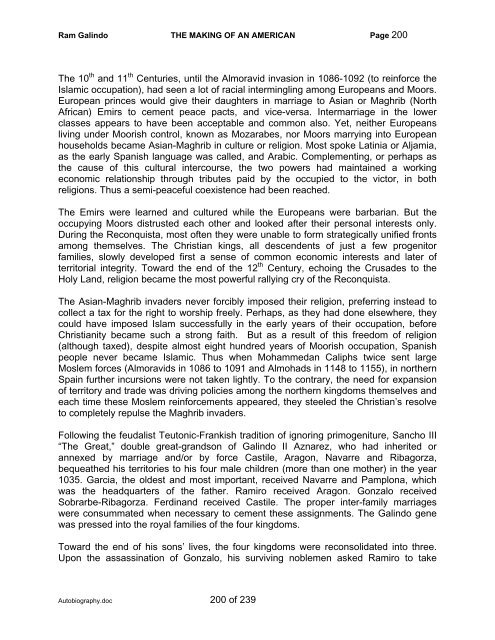Autobiography - The Galindo Group
Autobiography - The Galindo Group
Autobiography - The Galindo Group
You also want an ePaper? Increase the reach of your titles
YUMPU automatically turns print PDFs into web optimized ePapers that Google loves.
Ram <strong>Galindo</strong> THE MAKING OF AN AMERICAN Page 200<br />
<strong>The</strong> 10 th and 11 th Centuries, until the Almoravid invasion in 1086-1092 (to reinforce the<br />
Islamic occupation), had seen a lot of racial intermingling among Europeans and Moors.<br />
European princes would give their daughters in marriage to Asian or Maghrib (North<br />
African) Emirs to cement peace pacts, and vice-versa. Intermarriage in the lower<br />
classes appears to have been acceptable and common also. Yet, neither Europeans<br />
living under Moorish control, known as Mozarabes, nor Moors marrying into European<br />
households became Asian-Maghrib in culture or religion. Most spoke Latinia or Aljamia,<br />
as the early Spanish language was called, and Arabic. Complementing, or perhaps as<br />
the cause of this cultural intercourse, the two powers had maintained a working<br />
economic relationship through tributes paid by the occupied to the victor, in both<br />
religions. Thus a semi-peaceful coexistence had been reached.<br />
<strong>The</strong> Emirs were learned and cultured while the Europeans were barbarian. But the<br />
occupying Moors distrusted each other and looked after their personal interests only.<br />
During the Reconquista, most often they were unable to form strategically unified fronts<br />
among themselves. <strong>The</strong> Christian kings, all descendents of just a few progenitor<br />
families, slowly developed first a sense of common economic interests and later of<br />
territorial integrity. Toward the end of the 12 th Century, echoing the Crusades to the<br />
Holy Land, religion became the most powerful rallying cry of the Reconquista.<br />
<strong>The</strong> Asian-Maghrib invaders never forcibly imposed their religion, preferring instead to<br />
collect a tax for the right to worship freely. Perhaps, as they had done elsewhere, they<br />
could have imposed Islam successfully in the early years of their occupation, before<br />
Christianity became such a strong faith. But as a result of this freedom of religion<br />
(although taxed), despite almost eight hundred years of Moorish occupation, Spanish<br />
people never became Islamic. Thus when Mohammedan Caliphs twice sent large<br />
Moslem forces (Almoravids in 1086 to 1091 and Almohads in 1148 to 1155), in northern<br />
Spain further incursions were not taken lightly. To the contrary, the need for expansion<br />
of territory and trade was driving policies among the northern kingdoms themselves and<br />
each time these Moslem reinforcements appeared, they steeled the Christian’s resolve<br />
to completely repulse the Maghrib invaders.<br />
Following the feudalist Teutonic-Frankish tradition of ignoring primogeniture, Sancho III<br />
“<strong>The</strong> Great,” double great-grandson of <strong>Galindo</strong> II Aznarez, who had inherited or<br />
annexed by marriage and/or by force Castile, Aragon, Navarre and Ribagorza,<br />
bequeathed his territories to his four male children (more than one mother) in the year<br />
1035. Garcia, the oldest and most important, received Navarre and Pamplona, which<br />
was the headquarters of the father. Ramiro received Aragon. Gonzalo received<br />
Sobrarbe-Ribagorza. Ferdinand received Castile. <strong>The</strong> proper inter-family marriages<br />
were consummated when necessary to cement these assignments. <strong>The</strong> <strong>Galindo</strong> gene<br />
was pressed into the royal families of the four kingdoms.<br />
Toward the end of his sons’ lives, the four kingdoms were reconsolidated into three.<br />
Upon the assassination of Gonzalo, his surviving noblemen asked Ramiro to take<br />
<strong>Autobiography</strong>.doc 200 of 239


